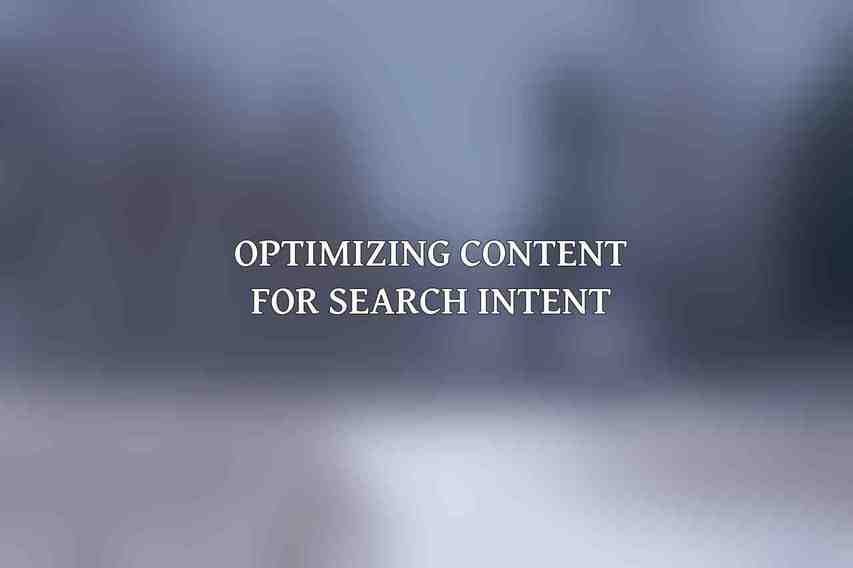Search intent, also known as user intent, refers to the reason behind a user’s online search query. Understanding search intent is crucial for SEO optimization as it helps ensure that the content you create aligns with what users are looking for. By tailoring your content to meet user needs, you increase the chances of ranking higher in search engine results pages (SERPs). Explore further with Comprehensive Guide to Keyword Research Techniques for SEO Success
Understanding User Search Behavior
A. Identifying the four types of search intent:
- Informational: Users seek specific information or answers to questions.
- Navigational: Users are looking for a particular website or web page.
- Transactional: Users intend to make a purchase or complete a specific action.
- Commercial: Users are researching products or services with the intent to buy.
B. Exploring user intent signals:
- Query analysis: Examining the length, specificity, and presence of modifiers in search queries can provide insights into user intent.
- SERP features: Paying attention to SERP features like featured snippets, image packs, and local results can indicate the dominant search intent.
- Past search history: User’s previous searches can reveal their interests and intentions.
- Contextual factors: Factors such as location and device type can influence search intent.
Categorizing Keywords Based on Search Intent
A. Keyword research techniques:
- Keyword brainstorming: Utilizing tools like Google Suggest and related searches to generate keyword ideas.
- Keyword mapping: Matching keywords to the identified search intent to ensure content relevance.
- Latent semantic indexing (LSI): Identifying semantically related keywords to enhance content optimization.
B. Tools for categorizing keywords:
- Google Keyword Planner: Provides search volume and intent data for keyword analysis.
- SEMrush: Offers keyword difficulty and intent analysis features for comprehensive research.
- Ahrefs: Includes tools like Keyword Explorer and Intent Explorer for in-depth keyword insights.
Optimizing Content for Search Intent

A. Creating content that aligns with user needs:
- Understanding the target audience is essential for tailoring content to meet their requirements.
- Providing relevant and valuable information that satisfies user queries is key to content optimization.
- Formatting content for readability and scannability enhances user experience.
B. Optimizing titles and meta descriptions:
- Including relevant keywords in titles and meta descriptions boosts search visibility.
- Accurately reflecting content intent in meta tags ensures users find what they expect.
- Maintaining optimal length for titles and meta descriptions improves click-through rates.
C. Using internal linking and anchor text:
- Connecting related pages through internal links helps search engines understand content hierarchy.
- Providing context and guiding users through well-optimized anchor texts enhances user navigation.
- Optimizing anchor text with relevant keywords can improve search engine rankings.
Tracking and Evaluating Results
A. Monitoring keyword rankings:
- Utilizing tools like Google Search Console or third-party tools to track keyword rankings over time.
- Monitoring progress and making adjustments based on performance data.
B. Analyzing website traffic:
- Using Google Analytics to measure traffic sources and user behavior on the site.
- Identifying high-performing keywords driving organic traffic for further optimization.
- Evaluating conversion rates to measure the effectiveness of the content in driving desired actions.
mastering search intent in keyword research is crucial for effective SEO optimization. By understanding and aligning with user search behavior, categorizing keywords based on intent, optimizing content, and tracking results, websites can achieve: Read more on Real-World SEO Success: Keyword Research Case Studies
1. Improved website relevancy and ranking.2. Enhanced user experience.3. Increased conversion rates.
By implementing these strategies and continually refining them based on data and user feedback, website owners can stay ahead in the ever-evolving world of SEO optimization.
Frequently Asked Questions
What is search intent?
Search intent refers to the reason behind a user’s search query. It’s important to understand if users are looking for information, making a purchase, seeking a specific website, or comparing products or services.
Why is search intent important in keyword research for SEO?
Understanding search intent helps you create content that aligns with what users are looking for, leading to higher visibility in search engine results pages and better engagement with your target audience.
What are the different types of search intent?
The common types of search intent are informational (seeking information), navigational (looking for a specific website), transactional (ready to make a purchase), and commercial investigation (researching products or services).
How can I identify search intent for keywords?
You can analyze search results, use tools like Google Trends and Google Keyword Planner, review related searches, and consider user behavior to understand the search intent behind keywords.
How can I optimize keywords for search intent in SEO?
To optimize keywords for search intent, create content that directly addresses the user’s search query, provides relevant information, and matches the intent behind the keyword. Use long-tail keywords and natural language that aligns with user queries. Find more on Top 10 Keyword Research Tools Reviewed for SEO Experts and Newbies

